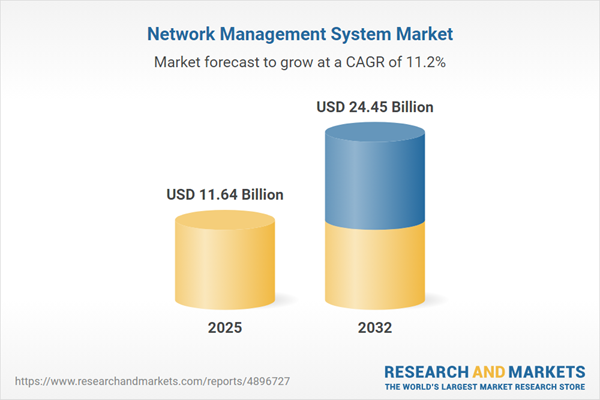Speak directly to the analyst to clarify any post sales queries you may have.
Network management system solutions are becoming essential foundations for enterprises seeking stable connectivity, stringent compliance, and seamless digital transformation. Senior decision-makers now recognize that overseeing complex digital networks requires strategic tools that can ensure robust performance and adaptability across diverse environments.
Market Snapshot: Network Management System Market
The global network management system market continues along a steady growth trajectory, driven by persistent corporate investment in digital infrastructure and transformation. In 2024, the sector reached a valuation of USD 10.44 billion, with a forecasted rise to USD 11.64 billion in 2025. This represents an 11.21% CAGR, underscoring the ongoing demand from enterprises for unified platforms capable of simplifying cloud migration, enhancing network visibility, and enforcing rigorous security and compliance standards. Industry leaders are responding with solutions developed to meet the complex challenges of digital modernization, regulatory shifts, and an evolving cybersecurity threat landscape.
Scope & Segmentation of Network Management System Solutions
Modern network management systems address operational challenges across the full spectrum of enterprise IT environments. These solutions prioritize flexibility, customization, and real-time response, allowing organizations to tailor deployments closely to their strategic requirements. Segmentation in the network management system market ensures alignment with the unique needs of different operational contexts.
- Component: Incorporates configuration management, event monitoring, robust fault and security detection, and end-to-end performance tracking, delivering transparency and control over hybrid, cloud-based, and on-premises infrastructures.
- Organization Size: Scalable platforms are designed for small businesses looking for agility, as well as large enterprises requiring advanced functionality across distributed operations.
- Deployment Type: Options span public cloud, private cloud, and on-premises solutions, enabling organizations to balance operational flexibility with regulatory obligations, risk mitigation, and data residency or sovereignty needs.
- End User: Solutions are optimized for various sectors, including financial services, government, healthcare, retail, IT, and telecom—each with distinct compliance, data protection, and operational requirements.
- Region: Adoption dynamics are influenced by local regulatory frameworks, investment trends, and varying security protocols across North America, Latin America, Europe, Middle East, Africa, and Asia-Pacific.
- Leading Vendors: Cisco Systems, Hewlett Packard Enterprise, Huawei, Nokia, Juniper Networks, IBM, Broadcom, NETSCOUT, SolarWinds, and Oracle bring expertise in delivering solutions suitable for regulated and mission-critical environments.
Key Takeaways for Senior Decision-Makers
- Centralized network management empowers executives with end-to-end visibility and unified control, supporting agility in adapting to evolving digital demands.
- Integration of artificial intelligence and machine learning enhances the speed and accuracy of threat detection, enabling preemptive actions across dynamic IT infrastructures.
- Flexible deployment options help organizations adapt rapidly to changing regulatory expectations and support expansion into new digital initiatives.
- Zero trust architectures strengthen protection, particularly for organizations with strict compliance goals or distributed user bases.
- Customizable features allow enterprises to address sector-specific data protection and governance mandates, reducing operational risk and supporting business continuity.
- Selecting experienced vendors supports consistent modernization and ensures effective alignment with corporate growth and compliance requirements.
Tariff Impact: United States 2025 Adjustments
Forthcoming US tariff modifications for 2025 are influencing decision-making on network management system procurement and deployment. Many organizations are prioritizing adaptable, software-defined platforms and flexible, subscription-based cloud services to manage the uncertainty. Enhanced coordination across procurement and IT operations helps maintain compliance and ensures resilient supply chains in the face of shifting trade and regulatory environments.
Methodology & Data Sources
This analysis draws on interviews with network architects, senior IT leaders, and cybersecurity professionals. Data validation included review against current sector literature and regulatory standards, reinforcing the relevance and accuracy of findings for enterprise stakeholders.
Network Management System Market: Why This Report Matters
- Presents actionable insights to mitigate risk and maintain continuity, supporting leadership through rapid shifts in digital and compliance practices.
- Guides decision-makers in synchronizing compliance, modernization, and operational strategies across diverse industries and enterprise sizes.
- Enables executives to prioritize reliability and security as they manage expanding hybrid and cloud-based transformations.
Conclusion
Network management systems provide a crucial foundation for resilient, secure, and future-ready IT operations. This report equips executive teams with clear, focused analysis to sustain effective oversight and drive long-term digital progress.
Additional Product Information:
- Purchase of this report includes 1 year online access with quarterly updates.
- This report can be updated on request. Please contact our Customer Experience team using the Ask a Question widget on our website.
Table of Contents
3. Executive Summary
4. Market Overview
7. Cumulative Impact of Artificial Intelligence 2025
List of Figures
Companies Mentioned
The companies profiled in this Network Management System market report include:- Cisco Systems, Inc.
- Hewlett Packard Enterprise Company
- Huawei Technologies Co., Ltd.
- Nokia Corporation
- Juniper Networks, Inc.
- IBM Corporation
- Broadcom Inc.
- NETSCOUT Systems, Inc.
- SolarWinds Corporation
- Oracle Corporation
Table Information
| Report Attribute | Details |
|---|---|
| No. of Pages | 192 |
| Published | November 2025 |
| Forecast Period | 2025 - 2032 |
| Estimated Market Value ( USD | $ 11.64 Billion |
| Forecasted Market Value ( USD | $ 24.45 Billion |
| Compound Annual Growth Rate | 11.2% |
| Regions Covered | Global |
| No. of Companies Mentioned | 11 |









